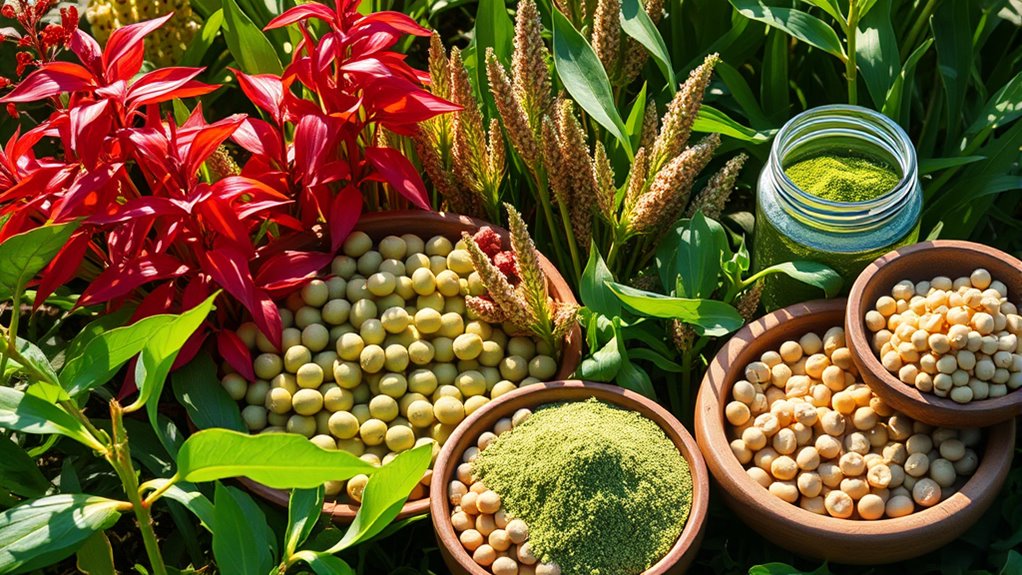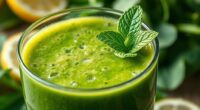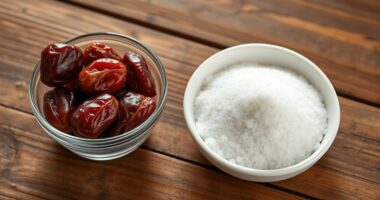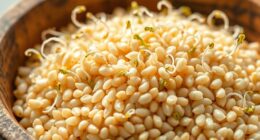You might be surprised to learn that many plant foods contain complete proteins, which you’ve probably overlooked. Options like quinoa, amaranth, and buckwheat are grains that offer all nine essential amino acids. Seeds like chia, hemp, and pumpkin also pack a complete protein punch in small servings. Algae such as spirulina and various seaweeds are highly nutrient-dense, while legumes like edamame and certain mushrooms provide full amino acid profiles. Keep exploring to discover even more plant-based protein sources you may not expect.
Key Takeaways
- Edamame and pumpkin seeds are plant-based sources providing complete proteins with all nine essential amino acids.
- Seaweed varieties like nori, kelp, wakame, and dulse are nutrient-dense, sustainable sources of complete plant proteins.
- Quinoa, amaranth, and buckwheat are grains and seeds naturally containing all essential amino acids.
- Spirulina, a blue-green algae, offers a high-quality, complete protein with additional nutrients and eco-friendly cultivation.
- Hemp seeds and chia seeds are tiny but rich sources of complete protein, healthy fats, and minerals, often overlooked as protein providers.
Quinoa: The Complete Grain Powerhouse
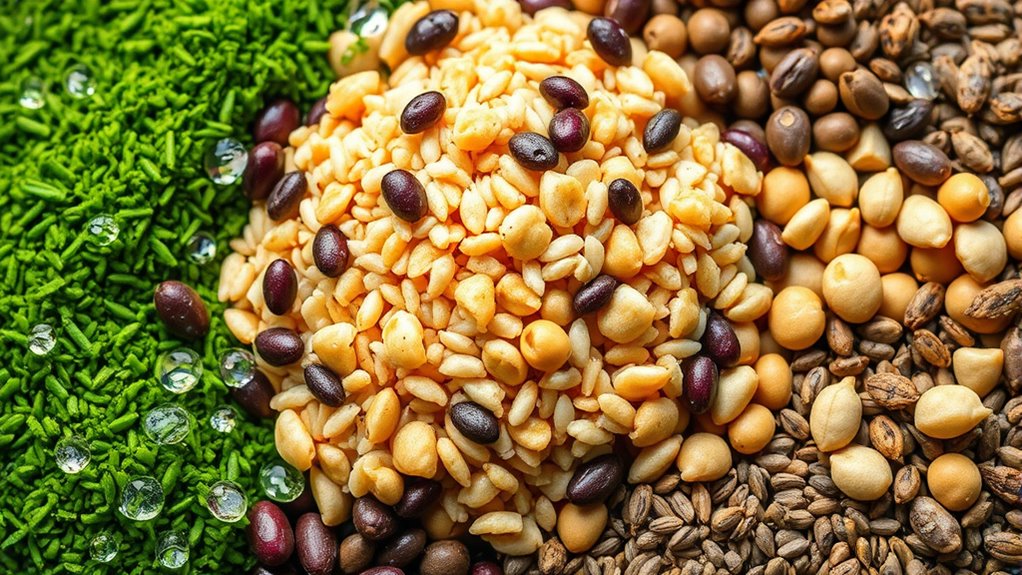
Have you ever wondered how a tiny grain can pack such a powerful nutritional punch? Quinoa is a true grain superfood that’s celebrated for its plant-based protein content. Unlike other grains, it contains all nine essential amino acids, making it a complete protein source. This means you get the benefits of a plant-based protein without needing to combine different foods. Quinoa is versatile—you can add it to salads, soups, or serve it as a side dish. Its high fiber and mineral content also support digestion and overall health. Incorporating quinoa into your diet is an easy way to boost your intake of complete proteins, especially if you’re looking to embrace more plant-based foods. It’s a nutrient-dense option that truly stands out among grain superfoods. Complete protein sources like quinoa are essential for balanced nutrition, especially in plant-based diets. Additionally, quinoa’s nutrient profile makes it a standout choice for those seeking a wholesome, plant-based protein option.
Amaranth: The Ancient Superfood
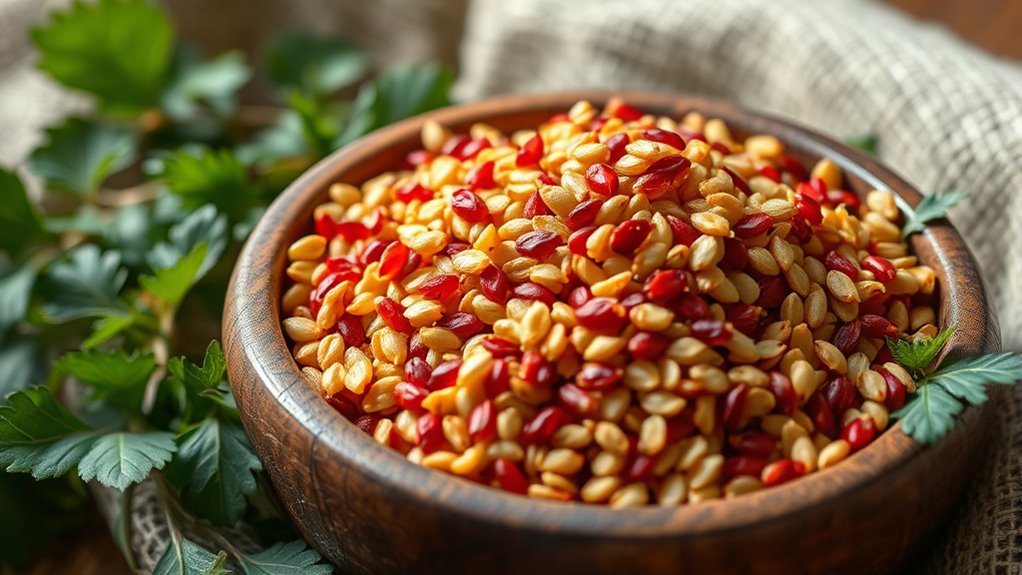
Amaranth, an ancient grain prized by civilizations like the Aztecs, stands out as a powerful plant-based protein source. Its superfood history dates back thousands of years, making it one of the oldest known ancient grains. Unlike typical grains, amaranth contains all nine essential amino acids, giving it complete protein status. This makes it especially valuable if you’re seeking plant-based options that support muscle growth and overall health. Its tiny seeds are nutrient-dense, offering not just protein but also fiber, iron, magnesium, and antioxidants. Today, amaranth is gaining popularity as a versatile, gluten-free superfood that can be cooked as porridge, added to salads, or used in baking. Its rich history and impressive nutritional profile make it a smart choice for diversifying your plant-based protein sources. Additionally, incorporating automation’s role in business intelligence can help optimize farming and distribution processes for superfoods like amaranth. Proper crop management techniques can further improve yield quality and nutritional content, ensuring a sustainable supply for health-conscious consumers. Understanding sustainable farming practices can also contribute to preserving the environment while producing nutrient-rich crops.
Buckwheat: A Gluten-Free Protein Source
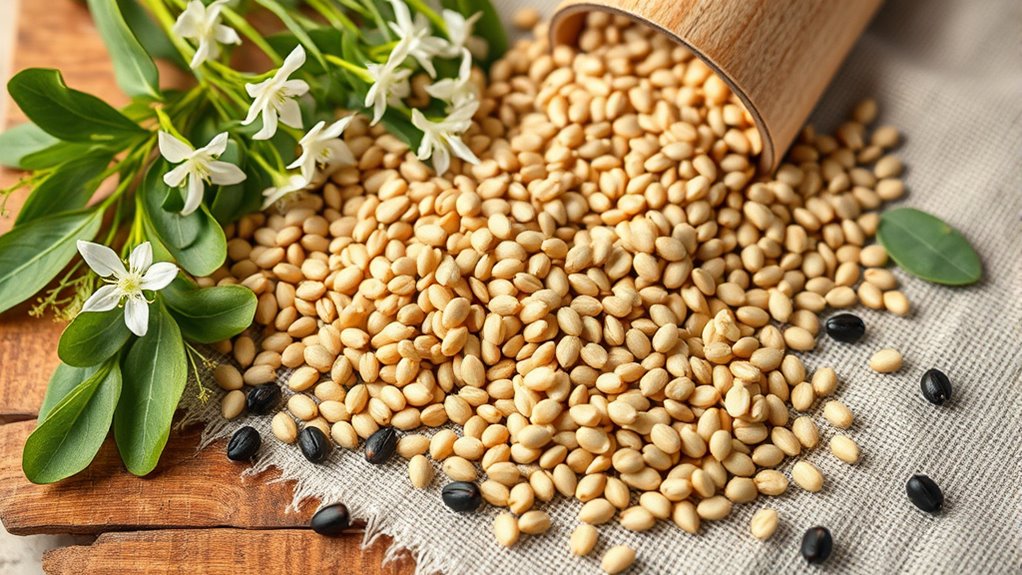
Did you know that buckwheat is a complete plant-based protein that’s naturally gluten-free? Unlike many gluten-free grains, it offers all nine essential amino acids, making it an excellent choice for plant-based diets. Buckwheat is versatile and easy to incorporate into your meals, whether as porridge, pancakes, or noodles. It’s a nutrient-dense option that provides not only high-quality protein but also fiber, antioxidants, and minerals like magnesium and manganese. Because it’s classified as a gluten-free grain, it’s suitable for those with celiac disease or gluten sensitivities. Including buckwheat in your diet boosts your intake of complete plant-based proteins and adds variety to your meals. Its rich nutritional profile makes it an underrated superfood for anyone seeking wholesome, gluten-free options. Understanding complete proteins helps highlight the importance of incorporating such grains into balanced diets, especially when prioritizing nutrient-dense foods for overall health. Additionally, its easy preparation makes it a convenient addition to any meal plan. Incorporating buckwheat can also support plant-based nutrition by providing essential amino acids that might be lacking in other vegetarian diets.
Spirulina: the Algae With All Essential Amino Acids

While buckwheat offers a versatile and complete plant-based protein, another remarkable source is spirulina, a blue-green algae packed with nutrients. Cultivated through algae cultivation, spirulina is easy to produce in controlled environments, ensuring consistent quality. It contains all essential amino acids, making it a complete protein source for vegans and vegetarians. Plus, its nutrient bioavailability is high, so your body can efficiently absorb crucial nutrients like B vitamins, iron, and antioxidants. Just a small amount provides a potent nutritional punch, supporting your immune system and energy levels. Incorporating spirulina into your diet is simple—add it to smoothies, energy balls, or salads. Its impressive nutrient profile and complete amino acid set make it a powerful addition to your plant-based protein options. Additionally, the easy cultivation methods of spirulina make it a sustainable and accessible superfood for many. nutrient bioavailability ensures that your body can make the most of the nutrients it provides. Moreover, its sustainable cultivation practices contribute to its status as an environmentally friendly superfood.
Chia Seeds: Tiny but Complete Protein Packets
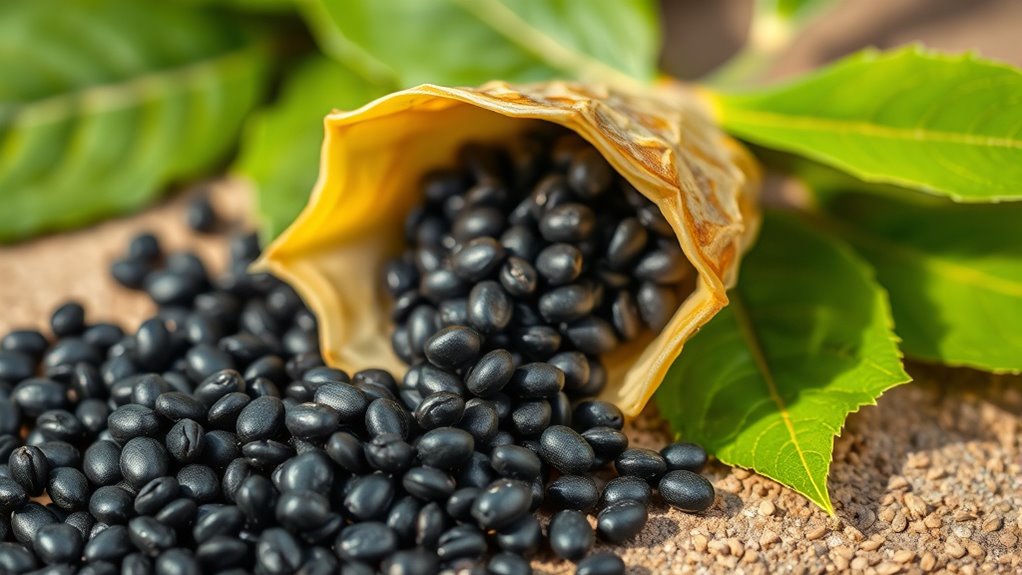
Have you ever considered how tiny seeds can pack a complete protein punch? Chia seeds are a perfect example, offering all nine essential amino acids in a small package. Many plant-based protein myths suggest seeds aren’t as nutritious as grains, but chia challenges that idea. Unlike grains, which often lack certain amino acids, chia seeds provide a balanced protein profile. They’re versatile, easy to add to smoothies, yogurt, or oatmeal. Here’s a quick comparison:
| Seeds | Grains |
|---|---|
| Complete protein | Often lacks some amino acids |
| Tiny and easy to add | Usually larger and bulkier |
| Rich in omega-3 | Higher in carbs |
Chia seeds prove you don’t need large servings to meet your protein needs—just a sprinkle goes a long way.
Hemp Seeds: Nutritious and Whole-Plant Protein
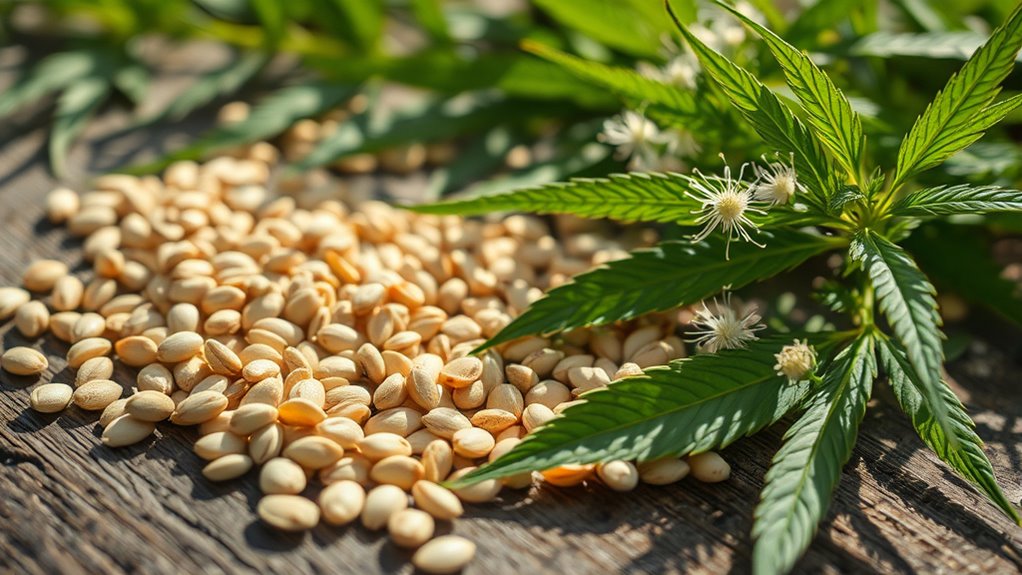
Hemp seeds are a powerhouse of nutrients, offering a complete protein along with healthy fats, fiber, and minerals. They’re incredibly versatile in the kitchen, adding a nutty flavor to salads, smoothies, and baked goods. Plus, hemp cultivation is eco-friendly, making it a sustainable choice for nutritious eating. Incorporating organic farming methods into hemp seed production can further enhance the environmental benefits of this nutritious crop. Implementing regulatory compliance measures ensures that hemp farming adheres to legal standards, supporting sustainable and responsible cultivation. Emphasizing sustainable agriculture practices can help preserve soil health and promote biodiversity in hemp farming regions. Additionally, adopting best practices in cultivation can optimize yield quality while minimizing environmental impact.
Nutrient Profile Highlights
Hemp seeds stand out as a highly nutritious plant-based protein source, offering a well-balanced nutrient profile. They contain all nine essential plant-based amino acids, making them a complete protein, unlike many other plant sources. When you compare hemp seeds to other protein options, they provide a rich mix of healthy fats, fiber, vitamins, and minerals like magnesium, zinc, and iron. Their protein content is easily digestible, supporting muscle repair and overall health. The complete protein comparison shows hemp seeds often surpass other plant proteins in quality, making them an excellent choice for vegans and vegetarians. Additionally, hemp seeds are a sustainable protein source, contributing positively to environmental conservation efforts. With their impressive nutrient profile, hemp seeds deliver both essential amino acids and indispensable nutrients, ensuring your diet remains balanced and nourishing.
Versatile Culinary Uses
Thanks to their mild nutty flavor and crunchy texture, hemp seeds are incredibly versatile in the kitchen. You can sprinkle them over salads, yogurt, or oatmeal for added crunch and nutrition. They work well in smoothies, blending seamlessly to boost protein content without altering flavor. Use them in baking by incorporating into muffins, energy bites, or bread dough for a subtle nutty taste. When it comes to cooking techniques, hemp seeds can be toasted to enhance their flavor or ground into a paste for spreads. Their mild flavor pairs well with ingredients like fruits, vegetables, chocolate, and spices, making them adaptable across sweet and savory dishes. Whether as a topping or a main ingredient, hemp seeds elevate your meals with their nutritional punch and versatile culinary applications.
Eco-Friendly Production
The production of hemp seeds stands out as an eco-friendly choice due to its minimal environmental impact. Hemp grows quickly, requires little water, and enriches the soil through nitrogen fixation, making it a sustainable sourcing option. Its cultivation uses fewer pesticides and herbicides, reducing chemical runoff. Additionally, hemp seeds are often packaged with eco conscious packaging, emphasizing minimal waste and recyclable materials. By choosing hemp-based products, you support environmentally responsible farming practices that promote soil health and reduce carbon footprints. This holistic approach to production aligns with your desire to make eco-friendly choices, ensuring that your nutrition supports both your health and the planet. Hemp seeds prove that nutritious, complete protein can be produced sustainably without harming the environment.
Edamame: Young Soybeans With Full Protein Profile
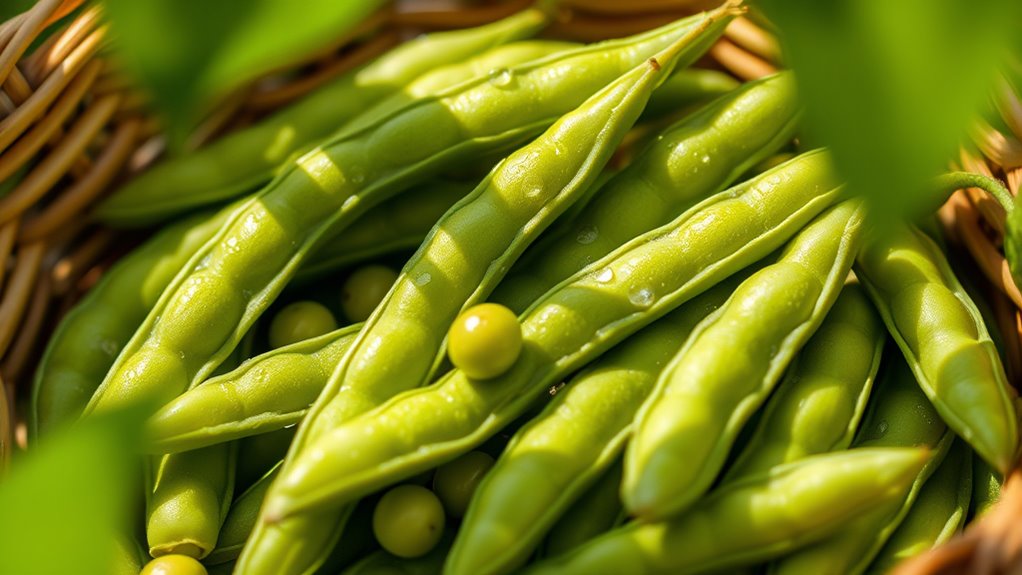
Edamame offers a rich nutrient profile, including complete plant-based protein, fiber, and essential vitamins. You can enjoy it in many dishes, from salads to snacks, thanks to its versatility. Its health benefits include supporting heart health and aiding digestion, making it a smart addition to your diet.
Nutrient Composition Highlights
Because edamame is a complete protein source, it provides all nine essential amino acids your body needs. Its nutrient profile highlights high-quality plant-based protein, complemented by fiber, vitamins, and minerals like folate and iron. The rich amino acid content results from ideal plant genetics and healthy soil nutrients, which influence protein synthesis. Imagine the following nutrient snapshot:
| Nutrient | Content per 100g |
|---|---|
| Protein | 11g |
| Fiber | 5g |
| Folate | 283mcg |
| Iron | 3.5mg |
This combination makes edamame a powerhouse. Its nutrient composition showcases how soil nutrients and plant genetics work together to produce a complete plant protein, making it a crucial addition to your diet.
Culinary Versatility Uses
With its mild flavor and firm texture, edamame offers a versatile ingredient that can be incorporated into countless dishes. You can enjoy them as a snack, toss them into salads, or blend them into dips for added protein. Edamame’s neutral taste pairs well with bold flavors like garlic, ginger, or spicy chili, making it ideal for stir-fries and grain bowls. They also work beautifully in pasta dishes, adding a pop of color and nutrition. For flavor combinations, consider mixing edamame with citrus, sesame, or soy-based sauces to enhance their natural taste. Whether you’re making a simple side or a complex entrée, edamame’s adaptability allows you to experiment with various cuisines and food pairings, making it an easy way to boost your plant-based protein intake.
Health Benefits Explained
Thanks to their mild flavor and versatile uses, edamame has become a popular plant-based protein source. Its health benefits go beyond taste, offering essential nutrients that support your well-being. For plant-based athletes, edamame supplies complete protein, aiding muscle repair and growth. Additionally, it’s rich in fiber, promoting healthy digestion and sustained energy levels. Incorporating edamame into vegan meal planning helps guarantee you meet daily protein needs without animal products. Here are some key benefits:
- Boosts muscle recovery and performance
- Supports digestive health with fiber content
- Provides antioxidants that reduce inflammation
- Enhances satiety, aiding weight management
Pumpkin Seeds: A Surprising Complete Protein Snack
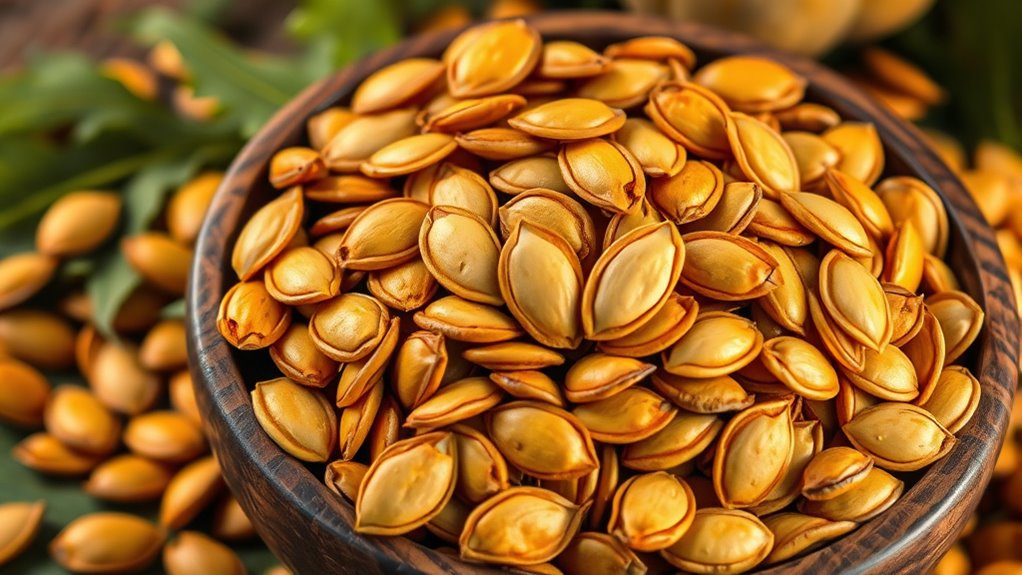
Although pumpkin seeds are often seen as a simple snack, they actually pack a powerful nutritional punch by providing all nine essential amino acids. This makes them a rare plant-based source of complete protein, supporting muscle repair and immune health. Their nutritional benefits extend beyond protein, offering healthy fats, magnesium, zinc, and antioxidants that promote overall well-being. Plus, pumpkin seeds boast remarkable culinary versatility—you can sprinkle them on salads, mix into yogurt, or enjoy them roasted as a snack. They’re easy to incorporate into your daily diet, making it simple to boost your protein intake without relying on animal products. With their impressive nutrient profile and adaptability, pumpkin seeds are a smart choice for anyone aiming to optimize their plant-based nutrition.
Seaweed Varieties: The Ocean’s Complete Protein Sources
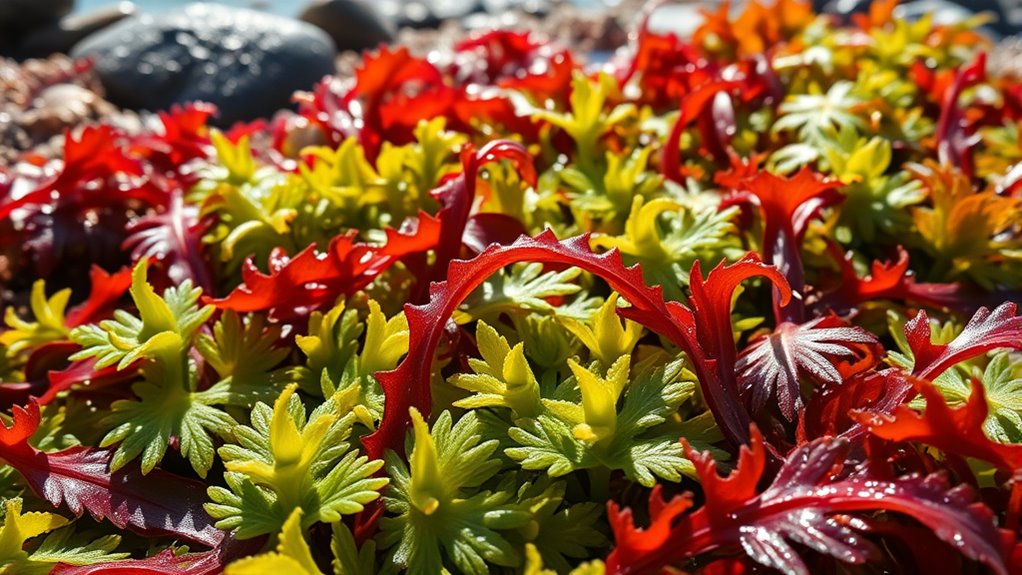
Seaweed offers a rich nutritional profile, making it a powerful plant-based protein source. You’ll find various edible types like nori, kelp, and wakame, each with unique benefits. Incorporating seaweed into your daily meals is simple and boosts your intake of complete protein and essential nutrients.
Nutritional Profile of Seaweed
Did you know that seaweed is a remarkable source of complete protein? Its nutritional profile offers more than just protein; it’s packed with essential nutrients. When cultivated through sustainable farming practices, seaweed provides a low-impact, eco-friendly option. Its mineral content is impressive, including iodine, calcium, magnesium, and iron, supporting various bodily functions. Here’s what makes seaweed stand out:
- Rich in all nine essential amino acids, making it a complete protein source
- High mineral density, especially iodine for thyroid health
- Low in calories, ideal for weight management
- Contains antioxidants and fiber, promoting overall wellness
Seaweed’s nutrient-dense profile makes it a valuable addition to plant-based diets, offering a sustainable and mineral-rich protein source you shouldn’t overlook.
Types of Edible Seaweed
With numerous edible seaweed varieties available, you can easily incorporate these versatile ocean plants into your diet for a complete protein boost. Popular options include nori, commonly used in sushi; kelp, rich in iodine and minerals; wakame, often found in soups and salads; and dulse, a flavorful snack. Sustainable harvesting practices guarantee these seaweeds are replenished naturally, supporting environmental health. Culinary innovations have expanded how we enjoy seaweed, from snack bars to plant-based protein powders. Each variety offers unique textures and flavors, making them adaptable ingredients in diverse dishes. By choosing a variety of seaweeds, you not only diversify your nutrient intake but also promote sustainable ocean farming. Incorporating these ocean vegetables can elevate your meals while harnessing their complete protein benefits.
Incorporating Seaweed Daily
Incorporating seaweed into your daily diet is easier than you might think, thanks to its versatility and availability. Its nutritional benefits include high levels of complete protein, iodine, and antioxidants. To add seaweed seamlessly, consider these options:
- Snack on roasted nori or kelp chips for a crunchy, nutritious treat.
- Stir chopped wakame or kombu into soups and stews for added flavor and nutrients.
- Use powdered spirulina as a supplement in smoothies or dressings.
- Incorporate dried seaweed flakes into salads or grain bowls.
Choosing sustainably harvested seaweed ensures you’re supporting ocean health while enjoying its rich nutritional profile. With these simple methods, you can effortlessly include this ocean’s complete protein sources in your everyday meals.
Certain Mushrooms: Unexpected Complete Proteins
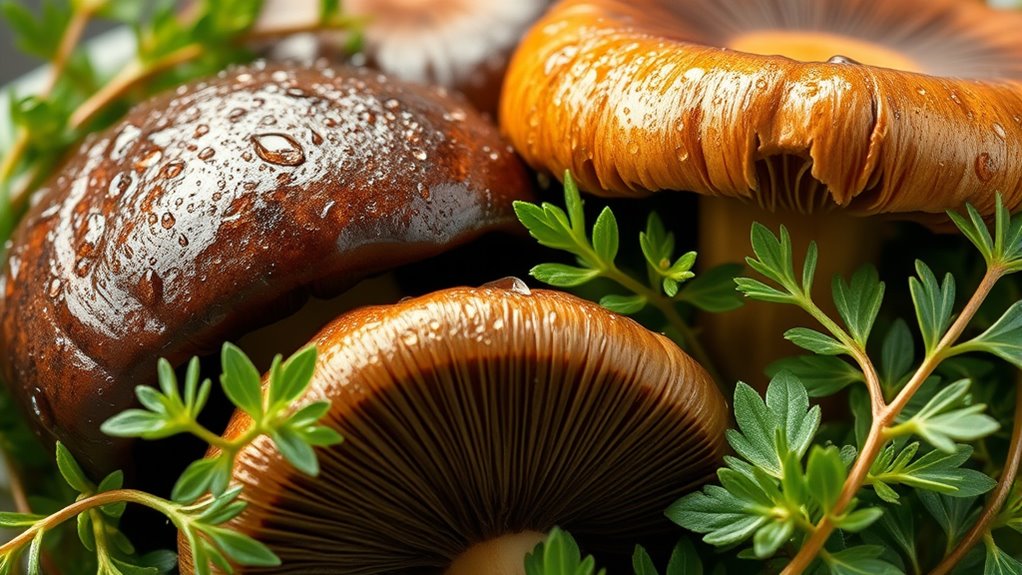
Although mushrooms are often valued for their flavor and texture, some varieties also provide a surprising source of complete protein. Certain mushrooms, like shiitake and maitake, excel in mushroom nutrition and boast a notable fungal protein content. These mushrooms contain all essential amino acids, making them a rare plant-based complete protein. To understand their benefits better, check out this quick comparison:
| Mushroom Type | Fungal Protein Content | Key Nutrients |
|---|---|---|
| Shiitake | High | B vitamins, antioxidants |
| Maitake | Moderate | Fiber, vitamin D |
| Portobello | Moderate | Selenium, potassium |
| Oyster | High | Iron, niacin |
Including these mushrooms in your diet boosts protein intake while adding flavor and variety.
Frequently Asked Questions
Can These Plant Proteins Meet All My Daily Nutritional Needs?
You might wonder if plant proteins can meet all your nutritional needs, but don’t fall for plant protein myths. Many plant sources, when combined properly, offer nutritional completeness, providing all essential amino acids your body requires. By eating a varied diet, you guarantee you get sufficient protein and other nutrients. So, yes, plant proteins can satisfy your daily nutritional needs if you diversify your choices and plan your meals thoughtfully.
Are These Plant Sources Suitable for All Dietary Restrictions?
Imagine a world where every plant source caters to your every dietary need—sounds like a dream, right? You’ll find many plant options suitable for gluten sensitivities and soy allergies, but not all. Some may still contain hidden gluten or soy traces. Always check labels carefully, and consider alternative sources like quinoa or amaranth. By doing so, you guarantee your diet stays inclusive and safe, no matter your restrictions.
How Do These Plant Proteins Compare to Animal-Based Proteins in Absorption?
When comparing plant proteins to animal-based ones, you’ll find differences in bioavailability and absorption efficiency. Plant proteins often have lower bioavailability, meaning your body absorbs them less efficiently than animal proteins. However, combining various plant sources can improve absorption. While animal proteins typically offer higher bioavailability, plant sources can still meet your needs if you diversify your intake. Balancing both can optimize your overall protein absorption.
Can I Get Enough Complete Protein From Plant Sources Alone?
Imagine your plate as a vibrant mosaic—each piece representing a different source of plant amino acids. Yes, you can get enough complete protein from plant sources alone if you practice smart protein blending. Combining legumes, grains, and seeds creates a symphony of essential amino acids that rival animal proteins. With mindful choices, your plant-based diet can fully support your protein needs, fueling your body just as effectively.
Are There Any Potential Allergies Associated With These Plant Proteins?
You might wonder if these plant proteins cause allergies. While they’re generally safe, some individuals experience allergy symptoms, which can trigger immune responses like swelling, hives, or difficulty breathing. It’s important to watch for any adverse reactions when trying new plant-based proteins. If you notice allergy symptoms, consult a healthcare professional to determine if these proteins are suitable for your diet and to avoid potential immune responses.
Conclusion
Did you know that plant-based sources can provide all nine essential amino acids? Incorporating foods like quinoa, spirulina, and edamame into your diet not only boosts your protein intake but also supports a more sustainable lifestyle. Surprisingly, studies show that plant proteins contribute to 25% of global protein consumption. So, next time you’re planning your meals, consider these overlooked superfoods—they’re delicious, nutritious, and perfect for a complete protein boost!

